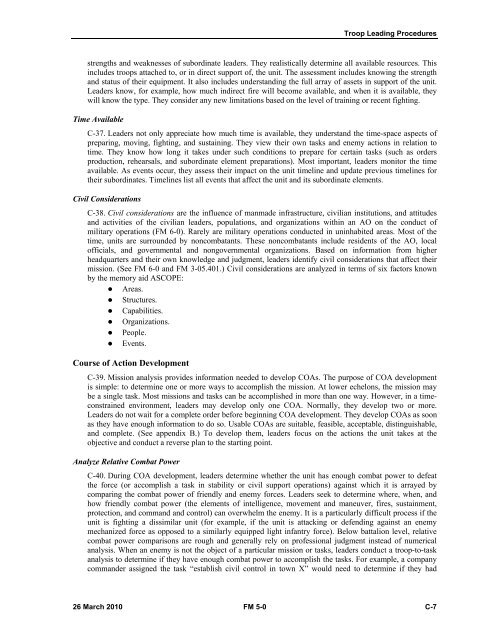FM 5-0, The Operations Process - Federation of American Scientists
FM 5-0, The Operations Process - Federation of American Scientists
FM 5-0, The Operations Process - Federation of American Scientists
You also want an ePaper? Increase the reach of your titles
YUMPU automatically turns print PDFs into web optimized ePapers that Google loves.
Troop Leading Procedures<br />
strengths and weaknesses <strong>of</strong> subordinate leaders. <strong>The</strong>y realistically determine all available resources. This<br />
includes troops attached to, or in direct support <strong>of</strong>, the unit. <strong>The</strong> assessment includes knowing the strength<br />
and status <strong>of</strong> their equipment. It also includes understanding the full array <strong>of</strong> assets in support <strong>of</strong> the unit.<br />
Leaders know, for example, how much indirect fire will become available, and when it is available, they<br />
will know the type. <strong>The</strong>y consider any new limitations based on the level <strong>of</strong> training or recent fighting.<br />
Time Available<br />
C-37. Leaders not only appreciate how much time is available, they understand the time-space aspects <strong>of</strong><br />
preparing, moving, fighting, and sustaining. <strong>The</strong>y view their own tasks and enemy actions in relation to<br />
time. <strong>The</strong>y know how long it takes under such conditions to prepare for certain tasks (such as orders<br />
production, rehearsals, and subordinate element preparations). Most important, leaders monitor the time<br />
available. As events occur, they assess their impact on the unit timeline and update previous timelines for<br />
their subordinates. Timelines list all events that affect the unit and its subordinate elements.<br />
Civil Considerations<br />
C-38. Civil considerations are the influence <strong>of</strong> manmade infrastructure, civilian institutions, and attitudes<br />
and activities <strong>of</strong> the civilian leaders, populations, and organizations within an AO on the conduct <strong>of</strong><br />
military operations (<strong>FM</strong> 6-0). Rarely are military operations conducted in uninhabited areas. Most <strong>of</strong> the<br />
time, units are surrounded by noncombatants. <strong>The</strong>se noncombatants include residents <strong>of</strong> the AO, local<br />
<strong>of</strong>ficials, and governmental and nongovernmental organizations. Based on information from higher<br />
headquarters and their own knowledge and judgment, leaders identify civil considerations that affect their<br />
mission. (See <strong>FM</strong> 6-0 and <strong>FM</strong> 3-05.401.) Civil considerations are analyzed in terms <strong>of</strong> six factors known<br />
by the memory aid ASCOPE:<br />
• Areas.<br />
• Structures.<br />
• Capabilities.<br />
• Organizations.<br />
• People.<br />
• Events.<br />
Course <strong>of</strong> Action Development<br />
C-39. Mission analysis provides information needed to develop COAs. <strong>The</strong> purpose <strong>of</strong> COA development<br />
is simple: to determine one or more ways to accomplish the mission. At lower echelons, the mission may<br />
be a single task. Most missions and tasks can be accomplished in more than one way. However, in a timeconstrained<br />
environment, leaders may develop only one COA. Normally, they develop two or more.<br />
Leaders do not wait for a complete order before beginning COA development. <strong>The</strong>y develop COAs as soon<br />
as they have enough information to do so. Usable COAs are suitable, feasible, acceptable, distinguishable,<br />
and complete. (See appendix B.) To develop them, leaders focus on the actions the unit takes at the<br />
objective and conduct a reverse plan to the starting point.<br />
Analyze Relative Combat Power<br />
C-40. During COA development, leaders determine whether the unit has enough combat power to defeat<br />
the force (or accomplish a task in stability or civil support operations) against which it is arrayed by<br />
comparing the combat power <strong>of</strong> friendly and enemy forces. Leaders seek to determine where, when, and<br />
how friendly combat power (the elements <strong>of</strong> intelligence, movement and maneuver, fires, sustainment,<br />
protection, and command and control) can overwhelm the enemy. It is a particularly difficult process if the<br />
unit is fighting a dissimilar unit (for example, if the unit is attacking or defending against an enemy<br />
mechanized force as opposed to a similarly equipped light infantry force). Below battalion level, relative<br />
combat power comparisons are rough and generally rely on pr<strong>of</strong>essional judgment instead <strong>of</strong> numerical<br />
analysis. When an enemy is not the object <strong>of</strong> a particular mission or tasks, leaders conduct a troop-to-task<br />
analysis to determine if they have enough combat power to accomplish the tasks. For example, a company<br />
commander assigned the task “establish civil control in town X” would need to determine if they had<br />
26 March 2010 <strong>FM</strong> 5-0 C-7















